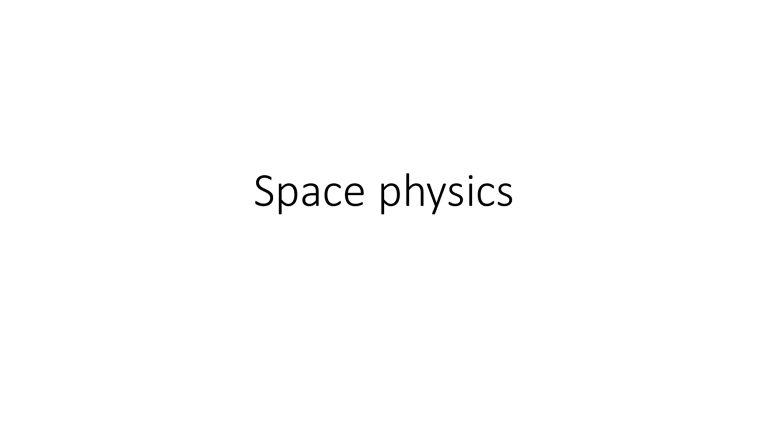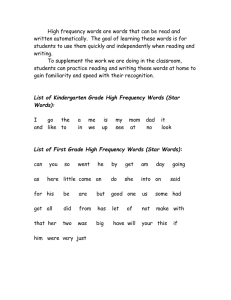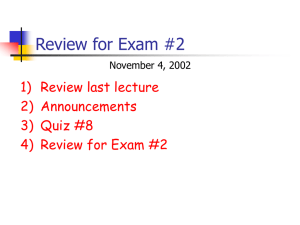
Space physics The motion of the earth • The motion of the earth can cause two different experiences: 1. Day and night 2. Seasons The cause of day and night The reason behind seasons • This is caused due to the earth orbiting the sun and it takes 365 days (1 year) to complete a full orbit. • Most countries (apart from those near the equator) experience four seasons and this is due to the slight tilt of the earth’s axis How far is the earth moving? • If we assumed that the earth’s orbit is circular, then the distance travelled by the earth is given by Example The moon The moon: continued…. • The moon takes approximately one month to orbit the earth and during its orbit it undergoes different phases The solar system The solar system The solar system The order of the planets The formation of the solar system Explanation: The sun was born Then the planets were born Formation of other objects The effect of gravity The greater the mass, the higher the gravitational field strength Distances in the solar system Example The effect of distance The effect of distance: continued…. • Distance can also affect the gravitational field strength of an object. The greater the distance from an object the weaker the gravitational field. • The gravitational field strength also depends on the mass of the object. The greater the mass, the stronger the field. Elliptical orbits • In elliptical orbits, the sun is not the center of the orbit • Planets have elliptical orbits Explaining elliptical orbits by using the law of conservation of energy As the planet gets close to the star it will have the minimum gravitational potential energy and the maximum kinetic energy. In this position the planet will be travelling at its maximum speed. As the planet is further away from the star, it will have the maximum gravitational potential energy and the minimum kinetic energy. At this position, the planet will be travelling at its minimum speed Analysing planetary data This table shows data about planets in Our solar system Stars and the universe What is a star? Nuclear fusion in stars Galaxies • A galaxy is a collection of billions of stars, all orbiting around a galactic center which is usually a black hole • Our solar system is part of a galaxy known as the Milky way. • The Milky way has a diameter of approximately 100,000 light years. Figure 2 Measuring large distances in light years Converting from light years into kilometers Life cycle of a star: A star is born • A star is born from interstellar clouds of gas and dust known as a stellar Nebula. • The element hydrogen must be present in the cloud for a star to form. • Because of gravity, the interstellar cloud starts to collapse upon itself and hydrogen and other elements start to clump together. • Then the temperature increases and this causes hydrogen nuclei to start fusing together. • As gravity pulls in more materials, the temperature increases further. At this stage, the star is called a protostar. The star becomes stable A star dies: https://www.youtube.com/watch?v=0RCtj2JVuXs Life cycle of a star: A star dies (average stars) • When an average star runs out of hydrogen, the outer layers expand and the star becomes a red giant. • When the red giant runs out of fuel, the outer layers will spread out further while cooling down becoming a loose cloud of gas and dust called a planetary nebula. • After the outer layers of the red giant spread out, the core of the star remains and the temperature remains extremely high and glows white, hence the name white dwarf. Life cycle of a star: A star dies (massive stars) • When massive stars begin to run out of hydrogen, the outer layers expand and the star becomes a red supergiant. Red supergiants can be up to 1000 times bigger than our sun. • When the red supergiant runs out of fuel, gravity pulls all the matter back into the centre. (this force of gravity is so huge due to the mass) • This causes a huge amount pf pressure which causes the star to violently explode. This explosion is called a supernova. • A supernova can then create a stellar nebula that can form stars and planets. • After the supernova, the core of the star is left behind. It has so much mass and therefore so much gravity crushing the atoms together and forming only neutrons. This is known as a neutron star. • If the star is massive enough, even neutrons cannot exist and all the matter in the core is crushed together into a single point. This creates a black hole which is the most dense object in the universe. Galaxies and redshift • The phenomenon of redshift tells us that stars and galaxies are moving away from the earth and this is an evidence that the universe is continuously expanding. • Redshift is an increase of the observed wavelength of electromagnetic radiation emitted from receding stars and galaxies. Explaining redshift Explaining redshift How fast are galaxies moving? The greater the redshift (ie. difference in wavelength), the greater the speed of the galaxy moving away from us) The universe More on CMBR Calculating the age of the universe Supernovae Hubble’s constant Example Solution


